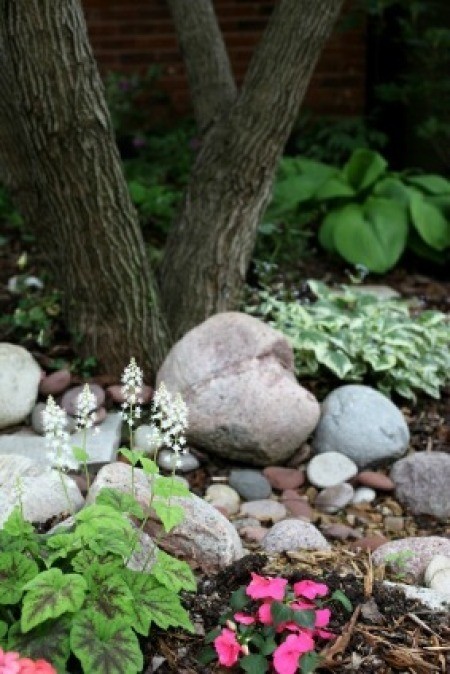If part of your yard is subject to shade, instead of trying to modify it, why not raise an attractive, diverse garden of shade loving plants? Shade gardens offer gardeners a lot of unique opportunities. The plants often have bolder and more colorful foliage than sun plants. And because shade gardens are not as prone to weeds or droughts as sun gardens, they tend to require less maintenance.
Guidelines for Shade Gardening
Assess Your Site. Different types of shade support different kinds of plants. Survey the shade in the different areas of your yard, and note the time of day that each area is shaded. This will help you determine the best plants for your shade garden.
Types of Shade
- Filtered (dappled) shade: A lightly shaded area where sunlight filters through tall, open-branched trees to the ground. Tall pine and trees that have been pruned or thinned usually give filtered shade.
- Partial shade: Bright light or direct sun for ½ the day and shade for ½ the day. Full afternoon sun is usually too much for shade-loving plants, but they are often happy with morning sun and afternoon shade.
- Full shade: Sun is obstructed for most of the day, year round. Full shade occurs in wooded areas with a mixture of tall trees and understory trees. Full shade may become partial shade in the winter when deciduous trees drop their leaves.
- Dense shade: Dark shade that lasts most of the day, all year long. Found under dense trees like evergreen magnolias, large spruces and other evergreen trees. Also found beside walls and hedges, and on the north side of buildings. No direct sunlight.
Lighten up with color: To lighten up deep shade, use plants with variegated leaves or bright blooms. For foliage, try coleus, pulmonaria, Jacob's ladder, coral bells, ivy, hosta, or Solomon's seal. For flowers, grow forget-me-nots, astilbe, impatiens, monkshood, columbine, or bleeding hearts.
Make green work for you: The main color you will work with in the shade garden is green. The good news is that there literally thousands of shades to choose from. Mixing bright greens with dark greens and mid-tone greens creates a sense of harmony. The light silver-green foliage of 'Jack Frost' Brunerra or the green and white variegated foliage of Solomon's seal work to brighten dim corners and make small spaces seem larger.
Compensate for competition: Soil fertility can be a source of trouble in the shade garden because the feeder roots from trees and shrubs tend to hog most of the water and nutrients. If your shade plants are located near trees, you will need to give them extra fertilizer and water'especially during droughts.
Choosing the Right Plants
- Annuals: Many annuals grow well in all but the densest of shade. Don't bother direct sowing seeds directly, because by the time they gather enough light and nutrients to bloom the season will be nearly over. Use bedding plants instead. Add light-colored impatiens, browallias, dwarf salvias, wax begonias and variegated coleus to your shade garden for even more color.
- Perennials: Perennials are the backbone of every flower garden'including shade gardens. Colorful perennials for a shade garden include hundreds of native wildflowers as well as showy cultivated plants such as astilbe and bleeding heart. Hellebores (also called Christmas rose) provide interesting form and color in winter, as do many types of mosses and ferns. It's always a good idea to place an emphasis on native plant species, because you know they are dependable performers for your area.
- Bulbs: Crocus, scillas, snowdrops, and species tulips will bloom before the trees leaf out and receive adequate amounts of sun. It's best to treat them like annuals, as a repeat performance the following year requires that their leaves receive full sun as they die back. Daffodils naturalize wonderfully open wooded areas and are often able to store enough reserves to come back on their own. When the bulb flowers are gone and the foliage starts to die back, later-blooming plants will provide needed cover.
- Groundcovers: Grasses don't grow well in the shade, especially under large trees. Instead, use perennial ground covers like Japanese spurge, snow-on-the-mountain, periwinkle, goutweed, and lily-of-the-valley (these can become invasive in some areas). Depending on your situation, you might also consider using some attractive, year round mulch.
- Evergreens vs. deciduous shrubs: Winter sun can be beneficial in the shade garden, so use large evergreens with restraint. Deciduous shrubs that produce berries such as winterberry add color while helping to feed wildlife. Plants with interesting bark such as birches or crape myrtle are also good choices.
Four Quick Tips for Starting a Shade Garden
- Start by cleaning up the area. Thin out unwanted saplings, damaged or unattractive trees, and undesirable brush. Then if necessary, prune off a few low hanging branches to allow in more light.
- Amend existing soil with organic matter to better hold soil moisture and give the roots of new plants a good start. If possible, dig in a 4 to 6 inch layer of organic matter each time you plant something.
- Follow nature's lead by 'stacking' plants in layers. Use taller trees to provide the 'ceiling', ground covers, bulbs, and perennials for the 'floor', and fill in the mid-level with shrubs and small trees. Plant around large tree roots instead of trying to cut through them.
- Water each plant as you set it in the ground, and apply organic mulch like bark, woodchips, or pine needles immediately after planting.
